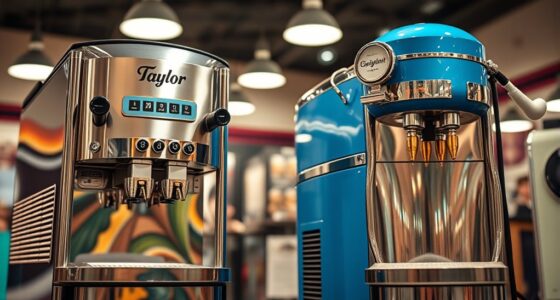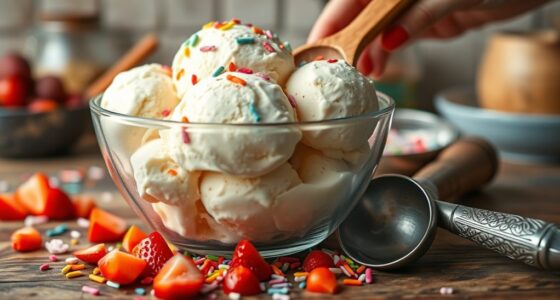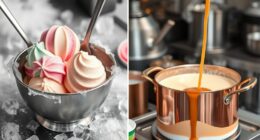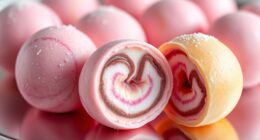Ice cream machines can be energy guzzlers, especially larger or commercial models that require continuous operation of compressors and motors. Home units typically use between 100 and 200 watts when running, which is manageable for occasional use. Factors like machine size, efficiency, and usage habits influence their energy consumption. If you want to discover tips for reducing power use and see how modern technology improves efficiency, keep exploring the details below.
Key Takeaways
- Home ice cream machines typically use 100-200 watts, making them manageable for personal use.
- Commercial models consume significantly more energy, impacting operational costs and efficiency.
- Energy use mainly occurs during freezing and churning, with longer operation increasing power consumption.
- Proper maintenance, insulation, and size selection can improve efficiency and reduce energy waste.
- Technological advances have led to more energy-efficient machines, decreasing their overall energy footprint.
How Do Ice Cream Machines Work and Their Energy Needs

Ice cream machines operate by combining ingredients and then freezing them while continuously mixing to create a smooth texture. During this process, you add your preferred ice cream flavoring, which blends into the base for rich, consistent taste. The machine’s compressor cools the mixture, requiring energy to maintain low temperatures. As the ice cream churns, it’s often packaged using specific packaging methods to preserve freshness and flavor. The energy needed to power the compressor and motor varies depending on the machine’s size and efficiency. Overall, understanding how your ice cream machine works helps you appreciate its energy demands, especially during prolonged use or frequent batches. Efficiency considerations play a role in how much energy the machine consumes over time. Additionally, the power consumption can be affected by the machine’s design and operational settings, making some models more energy-efficient than others. Recognizing the refrigerant type used in your machine can also impact its environmental footprint and efficiency. For example, energy-efficient models often incorporate advanced technologies to minimize power usage and reduce costs. Moreover, the technology used in compressors significantly influences the machine’s overall energy consumption and performance.
Average Power Consumption of Home Ice Cream Makers

While the power consumption of home ice cream makers varies depending on their size and features, most models typically use between 100 and 200 watts during operation. This energy use is generally manageable, especially if you enjoy making different ice cream flavors at home. Your machine may run longer for dense, creamy textures or shorter for softer results, affecting total energy use. When choosing flavors, consider how ingredients might influence freezing time; richer recipes may require more power. Serving suggestions, like adding toppings or mixing-ins, don’t impact energy consumption directly but can extend your ice cream’s preparation time. Additionally, awareness of AI security vulnerabilities can help ensure that digital appliances connected to smart home systems remain safe from cyber threats. Moreover, modern energy-efficient appliances are designed to minimize power consumption even during extended use. Being aware of energy-saving features in your ice cream maker can further help reduce electricity usage and lower your bills. For example, selecting models with automatic shut-off functions can prevent unnecessary energy drain. Incorporating proper insulation and placement can also help maintain optimal freezing conditions, reducing power requirements. Overall, home ice cream makers are fairly energy-efficient, allowing you to indulge in your favorite flavors without worrying about hefty electricity bills.
Commercial Ice Cream Machines: Energy Usage in Businesses

Commercial ice cream machines often consume significant energy, impacting your business’s operational costs. Understanding their energy consumption patterns helps you identify inefficiencies and potential savings. Managing these costs effectively can improve your bottom line and reduce environmental impact. Incorporating energy-efficient practices, such as regular maintenance and choosing models with better energy ratings, can further optimize consumption. Additionally, awareness of energy usage patterns can help in scheduling operation times to minimize costs and environmental impact. Considering tuning options for related equipment can also contribute to improved energy efficiency and overall performance. Properly maintaining equipment and upgrading to energy-saving components can significantly reduce energy consumption, leading to lower utility bills. Furthermore, selecting appropriate sprayer tips and maintaining equipment properly can reduce unnecessary energy expenditure in the process. Recognizing the importance of emotional safety in customer satisfaction can also influence operational decisions and equipment choices.
Energy Consumption Patterns
Understanding how commercial ice cream machines consume energy is essential for businesses aiming to cut costs and reduce their environmental impact. These machines primarily use energy during the freezing process, but their energy consumption also depends on factors like ice cream flavoring and storage temperature. When you add flavoring, especially if it requires mixing at specific temperatures, the machine may run longer or work harder to maintain ideal conditions. Additionally, maintaining proper storage temperature is vital; if the environment is too warm, the machine will need to cycle more frequently, increasing energy use. You can improve efficiency by ensuring ingredients are stored at the right temperature, reducing unnecessary workload on your machine. Recognizing these patterns helps you manage energy use effectively.
Cost Implications for Businesses
Energy consumption patterns directly impact the operating costs of ice cream machines in your business. Higher energy use means increased electricity bills, which can cut into your profit margins. Efficient machines can reduce costs associated with ice cream flavoring, as they often require precise temperature control to preserve flavor quality. Additionally, energy-efficient machines streamline ice cream packaging processes by maintaining consistent cooling, minimizing waste and spoilage. Over time, the savings from lower energy bills can offset the initial investment in more modern equipment. Being aware of your machine’s energy profile helps you make smarter decisions about upgrades or operational adjustments. Monitoring energy consumption and implementing energy-saving practices can further enhance efficiency. Integrating advanced machine technology can optimize overall energy use and improve operational performance. Staying informed about energy standards and regulations can also help ensure compliance and avoid penalties, ultimately benefiting your bottom line. Moreover, understanding the energy efficiency ratings of different models can guide you toward more sustainable choices. Ultimately, managing energy use not only saves money but also promotes sustainability, making your business more competitive and environmentally responsible.
Factors That Affect the Energy Efficiency of Ice Cream Machines
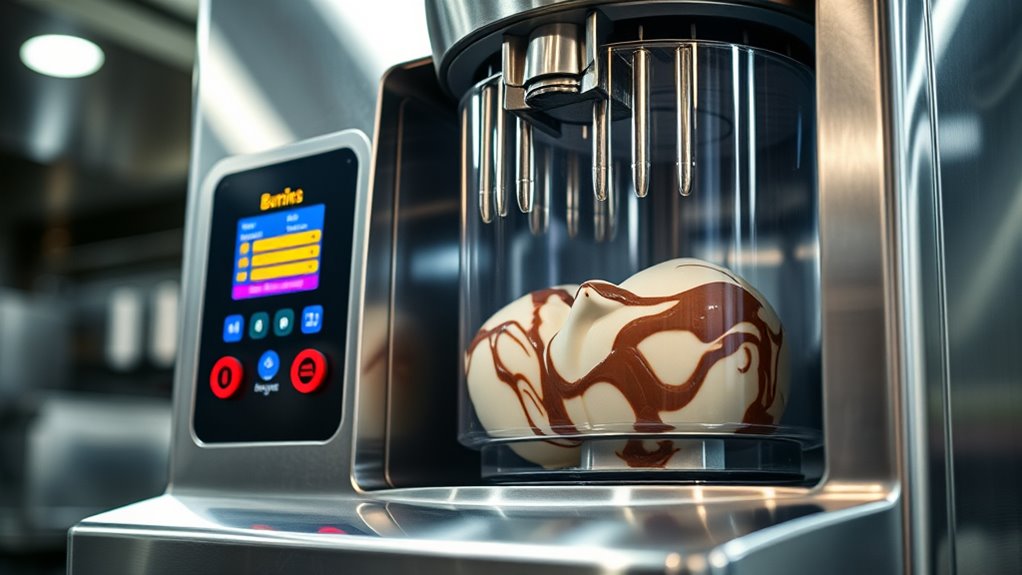
The size and capacity of your ice cream machine can considerably impact its energy efficiency, especially if it’s too large or small for your needs. How often and how long you use it also makes a difference in energy consumption. Additionally, proper maintenance and good insulation help keep energy use ideal and prevent unnecessary waste.
Machine Size and Capacity
Larger ice cream machines with greater capacity often consume more energy because they need to run longer or at higher power levels to produce and store larger batches. Your choice of machine size impacts energy efficiency directly—bigger machines require more electricity to operate effectively. Capacity planning becomes essential here; selecting a machine that matches your actual production needs helps prevent unnecessary energy waste. Oversized equipment may run more often or idle more, increasing energy costs without added benefit. Conversely, choosing a machine too small can lead to frequent runs, also wasting energy. By carefully evaluating your expected output, you can optimize machine size, ensuring efficient operation and reducing energy consumption while meeting your demand. Proper capacity planning is key to balancing performance and energy savings. Additionally, understanding how machine size influences energy consumption allows for more strategic decisions that can lower overall operational costs. Recognizing the importance of efficient operation can further enhance energy savings and sustainability efforts. Moreover, selecting energy-efficient models and incorporating energy-saving features can significantly reduce your overall energy footprint, especially when considering the energy consumption of different machine types. Incorporating regular maintenance of equipment also helps ensure that machines operate at optimal efficiency, reducing unnecessary energy use.
Usage Frequency and Duration
How often and how long you run your ice cream machine considerably impacts its energy efficiency. Frequent use without proper planning can increase energy consumption unnecessarily. If you offer various flavors for customization, only run the machine when needed for specific orders to avoid waste. Limiting continuous operation also helps prevent overheating and reduces wear. Efficient storage solutions for pre-mixed ingredients keep everything ready, so you don’t have to run the machine longer than necessary. Consider scheduling regular, shorter sessions instead of prolonged, sporadic runs. This approach minimizes energy use while maintaining flavor variety. By managing usage frequency and duration wisely, you can enhance your ice cream machine’s performance, save on energy costs, and ensure your equipment remains in good shape.
Maintenance and Insulation
Proper maintenance and effective insulation are key factors that influence your ice cream machine’s energy efficiency. Regularly cleaning coils and ensuring the refrigeration cycles run smoothly prevent unnecessary strain on the compressor, reducing energy consumption. Neglecting maintenance can lead to inefficient cooling, increasing power use. Additionally, choosing the right insulation materials helps retain cold temperatures more effectively, meaning the compressor doesn’t have to work as hard. Proper insulation minimizes heat transfer, saving energy and maintaining consistent product quality. Check for gaps or damage in insulation regularly, and upgrade if needed. Maintaining your machine well and using quality insulation materials optimize refrigeration cycles, cut down on energy waste, and extend the lifespan of your equipment.
Comparing Ice Cream Machines to Other Kitchen Appliances
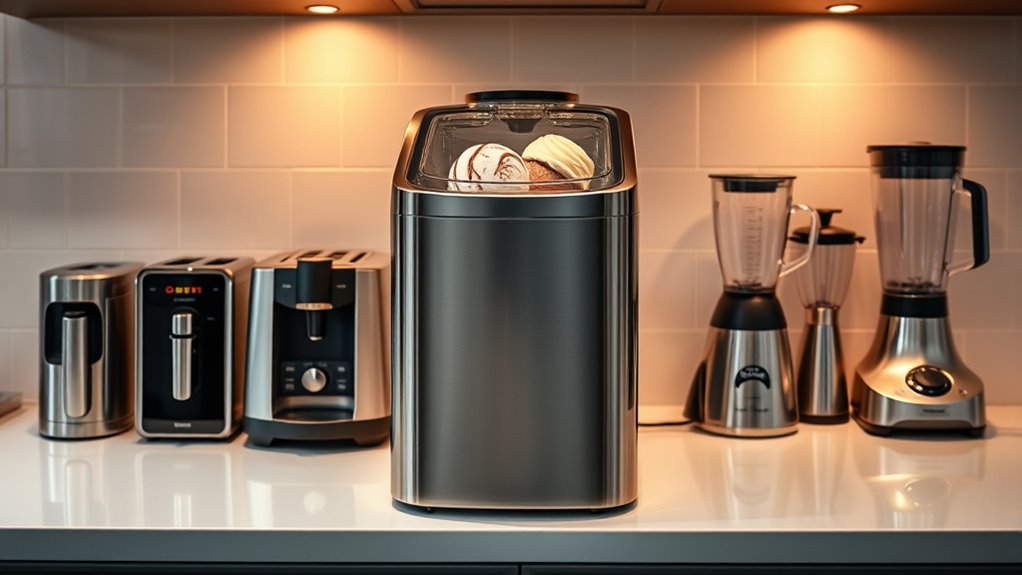
Ice cream machines often consume more energy than many other common kitchen appliances, making them notable energy guzzlers in household settings. Unlike refrigerators or toasters, ice cream makers require continuous motor operation during churning, which increases energy use. When compared to appliances like blenders or coffee makers, they generally have higher wattage and longer run times. Plus, if you focus on flavor customization and ingredient sourcing, you might spend additional time preparing ingredients, but this doesn’t considerably affect energy consumption. While a microwave or toaster may heat quickly and use less power, ice cream machines need sustained power to achieve smooth textures. Understanding these differences helps you evaluate whether the energy cost aligns with your desire for homemade treats and personalized flavors.
Tips to Minimize Energy Consumption While Making Ice Cream
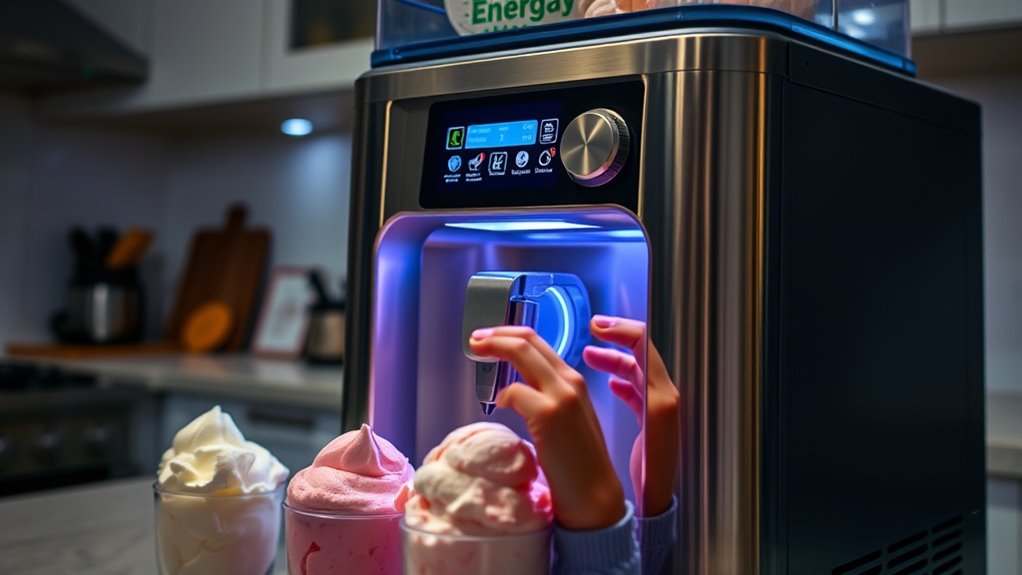
To reduce the energy your ice cream machine consumes, start by pre-chilling ingredients and the mixing bowl. This helps the machine work less to freeze your mixture. When choosing flavors and toppings, opt for those that don’t require extra preparation or refrigeration, cutting down on energy use. Avoid repeatedly opening the freezer or ice cream storage, as temperature fluctuations make the machine work harder. Store your ice cream in airtight containers to prevent melting and freezer burn, saving energy needed for refreezing. Consider making smaller batches; larger quantities take longer to churn and freeze. By managing ingredients, toppings, and storage carefully, you can enjoy your favorite ice cream while keeping energy consumption in check.
Energy Ratings and Certifications for Ice Cream Equipment

Understanding energy ratings and certifications for ice cream equipment is essential if you want to choose models that are efficient and environmentally friendly. These labels help you identify machines that use less energy and meet strict standards. Look for:
Choosing ice cream equipment with energy ratings ensures efficiency and eco-friendliness.
- Energy Star: This certification indicates the equipment meets high energy efficiency standards, saving you money and reducing environmental impact.
- Eco Certifications: These symbols show the product adheres to eco-friendly practices, such as sustainable manufacturing or reduced emissions.
- Efficiency Ratings: Many devices feature star or numerical ratings, making it easier to compare energy use at a glance.
Environmental Impact of Using Ice Cream Machines Regularly

Regularly using ice cream machines can substantially impact the environment, especially if the equipment consumes high amounts of energy over time. The refrigeration impact of these machines plays a significant role in their environmental footprint, as continuous cooling requires substantial energy. This constant energy use contributes to higher greenhouse gas emissions, especially if the electricity comes from fossil fuels. Additionally, the manufacturing and disposal of ice cream machines add to their overall environmental impact, producing waste and increasing resource depletion. When you operate these machines frequently, you’re not just consuming energy; you’re also contributing to climate change and environmental degradation. Reducing usage, opting for energy-efficient models, and maintaining equipment properly can help minimize this environmental footprint and promote more sustainable practices.
Cost Analysis: Energy Expenses Over Time

As you consider the long-term costs of ice cream machines, you’ll notice how operating expenses fluctuate over time. Advances in energy efficiency have started to reduce these ongoing expenses, making some models more economical. Understanding these trends can help you choose machines that save money in the long run.
Operating Cost Trends
Energy expenses for ice cream machines have shown significant variation over recent years, driven by advancements in technology and shifts in energy prices. These fluctuations impact your operating costs and influence how you manage your business. Consider these key trends:
- Rising energy costs due to supply chain disruptions increase expenses, prompting you to reassess equipment choices.
- Newer machines with smarter controls help reduce energy use, affecting overall operational costs.
- Marketing strategies now emphasize energy efficiency, encouraging consumers to prefer eco-friendly options, which can improve your brand image and sales.
Staying aware of these trends helps you anticipate changes in your operating costs, allowing you to adjust your budget and optimize energy consumption effectively.
Energy Efficiency Improvements
Advancements in technology have made modern ice cream machines considerably more energy-efficient, leading to noticeable changes in your electricity expenses over time. Improved machine design now minimizes energy waste, helping you save costs while maintaining your favorite ice cream flavor options. These new designs feature better insulation, optimized compressors, and smarter controls that reduce power consumption during operation. As a result, you’ll see a steady decline in energy expenses, especially if you switch from older models. Not only do these improvements cut costs, but they also help reduce your environmental footprint. Upgrading to an energy-efficient ice cream machine means you enjoy your dessert without worrying about skyrocketing electricity bills, making your business or home setup more sustainable and cost-effective in the long run.
Future Trends in Energy-Efficient Ice Cream Technology
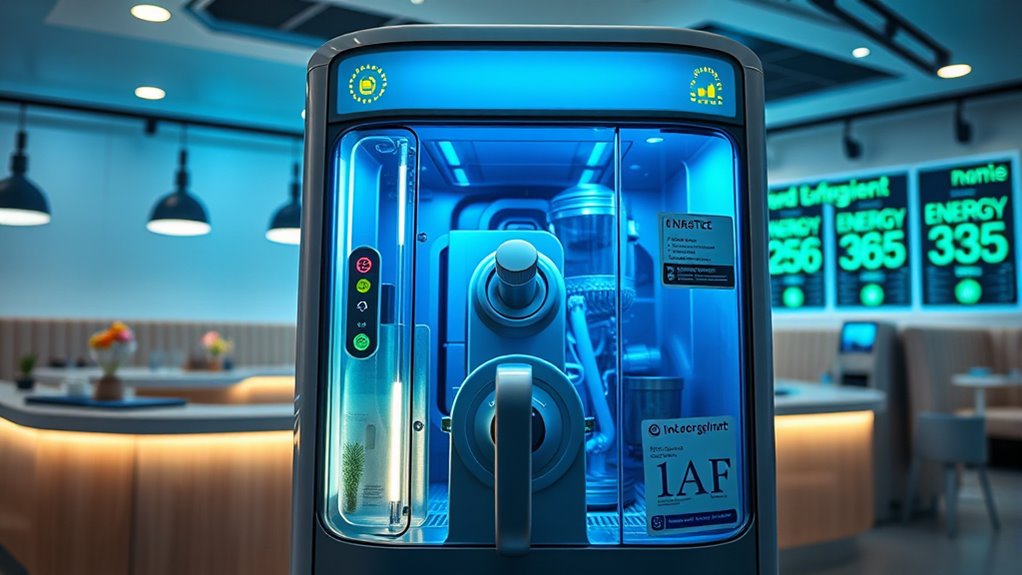
Emerging technologies are paving the way for more energy-efficient ice cream machines, driven by growing environmental concerns and rising operational costs. Future trends focus on reducing energy consumption while enhancing product quality. You can expect innovations like:
- Advanced refrigeration systems that cut power use without sacrificing cooling performance
- Integration of sustainable ingredients that lower environmental impact and appeal to eco-conscious consumers
- Flavor innovation through precise control technology, minimizing waste and maximizing efficiency
These advancements aim to make ice cream production more sustainable and cost-effective. By adopting energy-efficient designs and sustainable ingredients, you can help reduce your carbon footprint. The future of ice cream tech is about smarter, greener solutions that don’t compromise on flavor or quality.
Frequently Asked Questions
Are Energy-Efficient Ice Cream Machines Worth the Investment?
You wonder if energy-efficient ice cream machines are worth the investment. They can considerably reduce energy consumption, leading to cost savings over time. While the initial purchase might be higher, lower energy use means you’ll spend less on electricity bills. If you’re looking to cut costs and be more eco-friendly, investing in an energy-efficient machine is a smart choice that pays off in the long run.
How Can I Identify the Most Energy-Saving Ice Cream Machine Models?
To identify the most energy-saving ice cream machine models, you should look at their design and check energy consumption labels. Opt for machines with efficient, modern ice cream machine design features that reduce power use. Always compare energy labels to see which models consume less electricity. Choosing machines with clear energy ratings helps you save on energy costs and supports eco-friendly operations.
Do Different Ice Cream Recipes Affect the Machine’s Energy Consumption?
Recipe variations and ingredient impact can influence your ice cream machine’s energy consumption. Thicker or denser recipes, like those with more fat or sugar, may require longer churning times, using more energy. Conversely, lighter recipes tend to be more efficient. You can optimize energy use by adjusting ingredients to suit your machine’s efficiency, and experimenting with recipes to find a balance that minimizes energy while delivering great taste.
What Maintenance Practices Reduce Energy Use in Ice Cream Machines?
If you wanna save your ice cream machine from turning into a monstrous energy hog, you’ve gotta master the art of maintenance! Regular machine cleaning prevents buildup that forces it to work overtime, while refrigerant maintenance keeps it running smoothly without wasting energy. Skipping these steps is like giving your machine a caffeine boost—except it’s an energy guzzler in disguise. Keep it clean and refrigerant-healthy, and watch your energy bills shrink!
Can Smart Technology Optimize Ice Cream Machine Energy Efficiency?
You can optimize ice cream machine energy efficiency with smart technology by reducing manual operation and managing flavor variability. Smart systems monitor usage patterns, automatically adjusting temperature and compressor cycles, which cuts down energy waste. They also help maintain consistent flavors, preventing unnecessary reprocessing. By automating these processes, you conserve energy, improve efficiency, and ensure your ice cream remains fresh and delicious, all while minimizing manual effort.
Conclusion
So, next time you indulge in ice cream, remember you’re not just fueling your sweet tooth but also your machine’s insatiable energy appetite. While some fancy models boast eco-friendly labels, they still sip power like a fancy latte. Ultimately, whether you’re a casual scooper or a business owner, being mindful of energy use keeps your wallet—and the planet—less frozen in time. After all, who knew ice cream could be such an energy guzzler?



